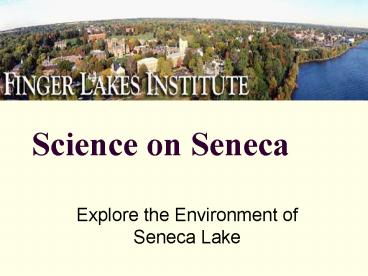Science on Seneca - PowerPoint PPT Presentation
1 / 24
Title:
Science on Seneca
Description:
Science on Seneca – PowerPoint PPT presentation
Number of Views:40
Avg rating:3.0/5.0
Title: Science on Seneca
1
Science on Seneca
- Explore the Environment of Seneca Lake
2
Welcome to Hobart and William Smith Colleges
3
Finger Lakes Region
- WatershedArea 5000 km²
- Drinking Water SupplyRochester, Syracuse,
Ithaca, Geneva, Auburn - Tourism Recreation
- 22 million tourists visit the region-generates
2.6 billion in revenue - Agriculture
- 45 Agricultural land use
- 35 Forested
4
Science on Seneca Field Trip
- Purpose To learn more about the ecology of
Seneca Lake while assisting in the collection and
interpretation of scientific data on the lake.
5
Boat Etiquette
- The Boat William Scandling
Captain John
6
Data Collection Physical Parameters
- Transmission of Light Secchi Disk
- Wind Speed and Direction
- Water Temperature Profile
- CTD
7
Secchi Disk and Productivity
Productive Lake algae bloom.
8
Water Temperature in Lakes
- Cold water is more dense than warm water.
- Thermocline separates the warm water from the
cold water. - Water has a high specific heat index.
9
Chemistry
- pH pH meter
- Chloride titration
- DO titration
10
pH
- pH measures impact of acid rain on the lake.
- Hardness is an indicator of the concentration of
CaCO3. - Drinking Water Standards for Hardness and pH
11
(No Transcript)
12
Chloride in Seneca Lake
13
http//www.dec.state.ny.us/website/reg8/lakes/lake
pro.gif
14
Factors Affecting Dissolved Oxygen
- Water Temperature
- Photosynthesis
- Respiration
- Aeration
- Decay uses up oxygen.
15
Biology
- Biological Diversity plankton nets to collect
samples of plankton and zooplankton
Zooplankton (Daphnia)
Phytoplankton (Diatom)
Daphnia pulex
Astrerionella
16
Students using plankton net
17
Plankton Sample
18
Sediment dredge
19
Quaggas and Zebra Mussels
Zebra Mussel
Quagga Mussel
20
What Happens to the Food Chain?
Fish and other organisms
Invasive Mussels
Grazers
Nutrients
Producers
21
Zebra Mussels and Seneca Lake Secchi Depths
Zebra Introduction
Zebra Die Off
Zebra Rebound Quagga Introduction
22
Geology
- Sediment Character
23
Life in Geological Time
- Sediments contain clues as to the type of life
that existed over time in the Finger Lakes. - For example students examining sediments during
SOS 20 years ago would not have found zebra
mussels because they did not inhabit Seneca Lake!
24
Science on Seneca
- Looking forward to seeing you!
- Website http//fli.hws.edu/
- Credits Barb Busack, CABOCES Sheila Myers,
FLI Sarah Meyer, FLI Jim Makinster, FLI Eric
Primrose, FLI John Halfman, FLI plankton
pictures by Wim van Egmond Paleontological
Research Institute, Ithaca NY. Bob Dedrick,
Canandaigua Schools.

